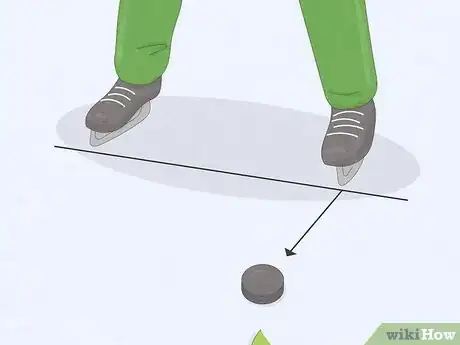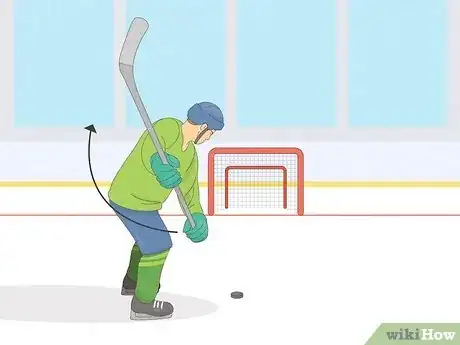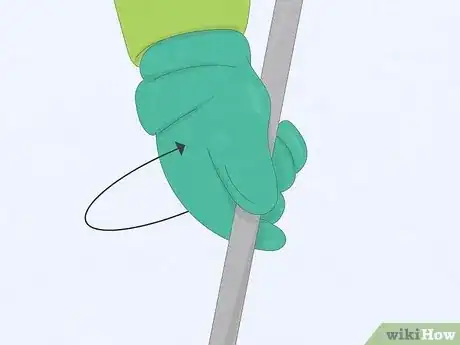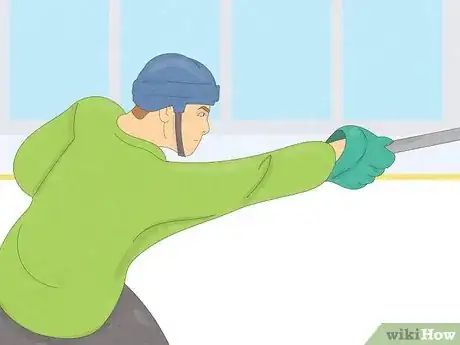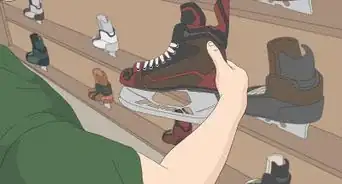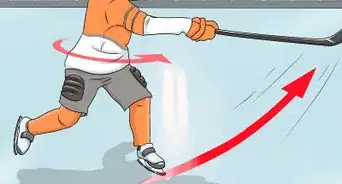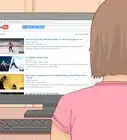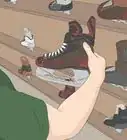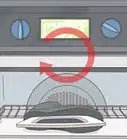This article was co-authored by wikiHow Staff. Our trained team of editors and researchers validate articles for accuracy and comprehensiveness. wikiHow's Content Management Team carefully monitors the work from our editorial staff to ensure that each article is backed by trusted research and meets our high quality standards.
This article has been viewed 253,190 times.
Learn more...
The slap shot is an important part of any hockey game. When performing a slap shot, the hockey stick is aggressively slapped (nearly as hard as you can) and bent on the ice. Tension builds up in the stick as it flexes, and this tension is then released against the puck in the direction of the intended target. Even though this technique can generate a puck speed of over 100 mph (160 km/h), it's not as accurate or as convenient as the wrist or snap shots.
Steps
Positioning Yourself for a Slap Shot
-
1Decide when to take a slap shot. Slap shots are used primarily by defensive players when in position near the point (the spot where the blue line intersects the boards on the defensive side of the rink). Although slap shots are flashy and can impress a crowd, they're not used very often during a hockey game. The vast majority of the time, something simpler will work better.[1]
- That said, any time you can use a slap shot to your advantage in a hockey game, take the shot!
-
2Point your feet towards the puck. At this point, the puck should be about 3 feet (0.9 m) in front of your skates.[2] Do not point your skates at your target (i.e. the net); this is a common mistake made by beginners. Stand perpendicular to the net, so that your shoulders are pointing towards it.
- Once you're feeling more comfortable performing slap shots, you can take a shot with your feet a little crooked. This stance can be useful if you're short on time during a play, or cannot position yourself correctly for the shot.
Advertisement -
3Locate your hands shoulder-width apart on the stick. If you're right-handed, place your left hand at the top of your stick. Place your right hand lower than where you would normally carry it when stick-handling or skating: so, about shoulder-width apart. As the stick reaches its highest point during the slap shot, your hands will separate a little more and move down the shaft. Then, as you finish the shot, your hands should end up back at shoulder-length apart.[3]
- A majority of left handed hockey players shoot on the left making these instructions completely backwards. Your right hand would be on the top of the stick because you would use your dominant hand for best control.
Winding Up for the Shot
-
1Take an athletic stance. When preparing to take a slap shot, stand with your feet about shoulder-width apart. Also bend your knees slightly; this will give you greater control over the distribution of your weight as you lean forward during the slap shot.[4]
- It's impossible to take a slap shot while you're skating. You need to be static on the ice, even if only for a few seconds.
-
2Raise your stick behind you to wind up. Pull the stick back to the level of your waist. As you wind up, let the weight of your body shift backwards, until most of your weight is resting on your back leg. Winding up this way will allow you to build up momentum as you swing the stick forward toward the puck.[5]
- Don't wind up to an extreme degree; winding up way above your head doesn't add power and sacrifices time and accuracy. Especially as a beginner, while trying to learn the overall movement, during the windup don't bring the blade of your stick any higher than your waist.
- Once you become more proficient at slap shots, you can start to increase your windup. Many pro players wind up as high as their shoulders.
-
3Take a look at the goal and aim as you wind up. If you're aiming for the opposing team's net, you should aim for a particular spot on the net, not just the net itself. Aiming for a very specific spot on the net will allow your greater accuracy, and you'll be more likely to make the shot.
- If you're taking a slap shot from across the hockey rink, it's unlikely that you'll put the puck in the goal.
- In hockey games, many players rely on their teammates to "tip" the puck into the opponent's goal. Keep your eyes on the ice and on your teammate's stick side.
Making the Slap Shot
-
1Shift your momentum to your forward leg. As you start to swing your stick down towards the puck, transfer the weight of your body forward, onto your front leg. This will give your slap shot plenty of momentum, and you'll be able to drive the puck farther and with more speed.[6]
- Shifting your weight forwards will add to the energy and power of your shot.
-
2Make contact with the ice inches before you hit the puck. Many mistakenly hit only the puck, thinking the ice will slow their shot. If performed correctly, however, hitting the ice with your stick just before contact with the puck will cause your stick to "flex" and build up energy. Once your stick hits the puck, it will straighten out and transfer the energy from the "flex" into the puck itself.[7]
- Aim to hit the ice between 3 and 5 inches (8-13 cm) before the puck. This takes practice, but it's arguably the single most important part of a slap shot.
-
3Turn your wrists upward as you swing. Just at the point when your stick contacts the puck, roll your wrists so that the thumb on your dominant hand (right hand if right-handed, left hand if left-handed) turns down towards the ice.[8] This is where most of your accuracy comes from and will give you the ability to aim the direction in which the puck flies.
- Even if you point your stick, the aim of your shot will be inaccurate if you don't roll your wrists during your contact with the puck.
-
4Follow through with your shot. After initial contact, follow through with your stick, arms, and torso, in the direction you want the puck to go. This makes for a more accurate shot, and it also helps keep your puck stable in the air. Your shoulders should finish facing the net, your hips should twist towards the direction of the shot, and your front foot should turn towards the direction of the shot.[9]
- After following through, your stick and body should be pointing (gliding) towards the direction of your shot.
- Roughly speaking, the direction that the blade of your stick points in during follow-through shows where your shot will end up. If your blade is high off the ground, your shot will end up high; if your blade is low, the shot will be low too.
Community Q&A
-
QuestionHow do I tape my ears to my helmet?
 Community AnswerHead to your local hockey store and buy some high quality stick tape. (The more expensive the better.) Make a little roll out of the tape, so that the sticky side is facing outwards, and firmly press it to your ear. Proceed to put on your helmet as usual.
Community AnswerHead to your local hockey store and buy some high quality stick tape. (The more expensive the better.) Make a little roll out of the tape, so that the sticky side is facing outwards, and firmly press it to your ear. Proceed to put on your helmet as usual. -
QuestionHow do I get a slap shot high off the ice?
 Community AnswerFollow through higher. Note: This is usually a bad thing. Keep your shots down low.
Community AnswerFollow through higher. Note: This is usually a bad thing. Keep your shots down low. -
QuestionHow do I put my helmet back together? I got hit with a slap shot in the head and my helmet cracked.
 Community AnswerIt's best that you get a new helmet if this happened. A cracked helmet will no longer provide you as much protection as before.
Community AnswerIt's best that you get a new helmet if this happened. A cracked helmet will no longer provide you as much protection as before.
References
- ↑ http://icehockey.isport.com/icehockey-guides/how-to-take-a-slap-shot-in-ice-hockey
- ↑ http://www.hockeytutorial.com/ice-hockey-tips/how-to-take-a-slap-shot-in-hockey-video-tutorial-on-ice-hockeytutorial-com-3/
- ↑ http://www.hockeytutorial.com/ice-hockey-tips/how-to-take-a-slap-shot-in-hockey-video-tutorial-on-ice-hockeytutorial-com-3/
- ↑ http://icehockey.isport.com/icehockey-guides/how-to-take-a-slap-shot-in-ice-hockey
- ↑ http://icehockey.isport.com/icehockey-guides/how-to-take-a-slap-shot-in-ice-hockey
- ↑ http://www.omha.net/news_article/show/453909?referrer_id=1063069
- ↑ http://www.omha.net/news_article/show/453909?referrer_id=1063069
- ↑ http://icehockey.isport.com/icehockey-guides/how-to-take-a-slap-shot-in-ice-hockey
- ↑ http://icehockey.isport.com/icehockey-guides/how-to-take-a-slap-shot-in-ice-hockey

